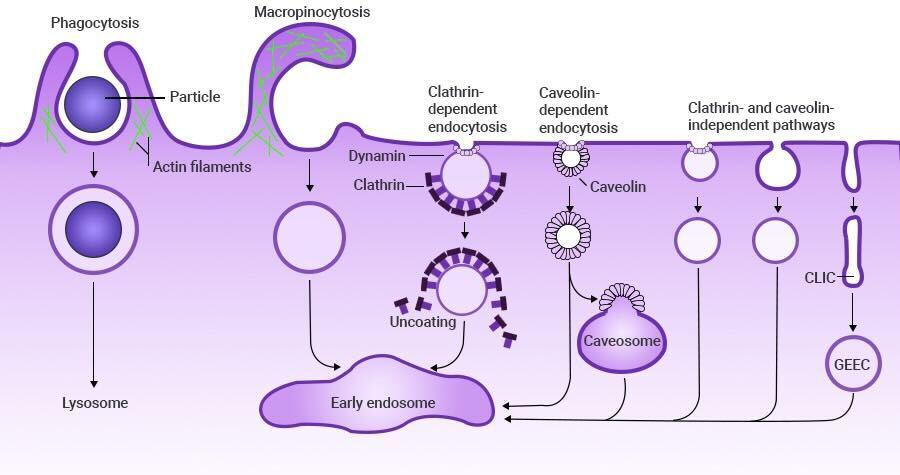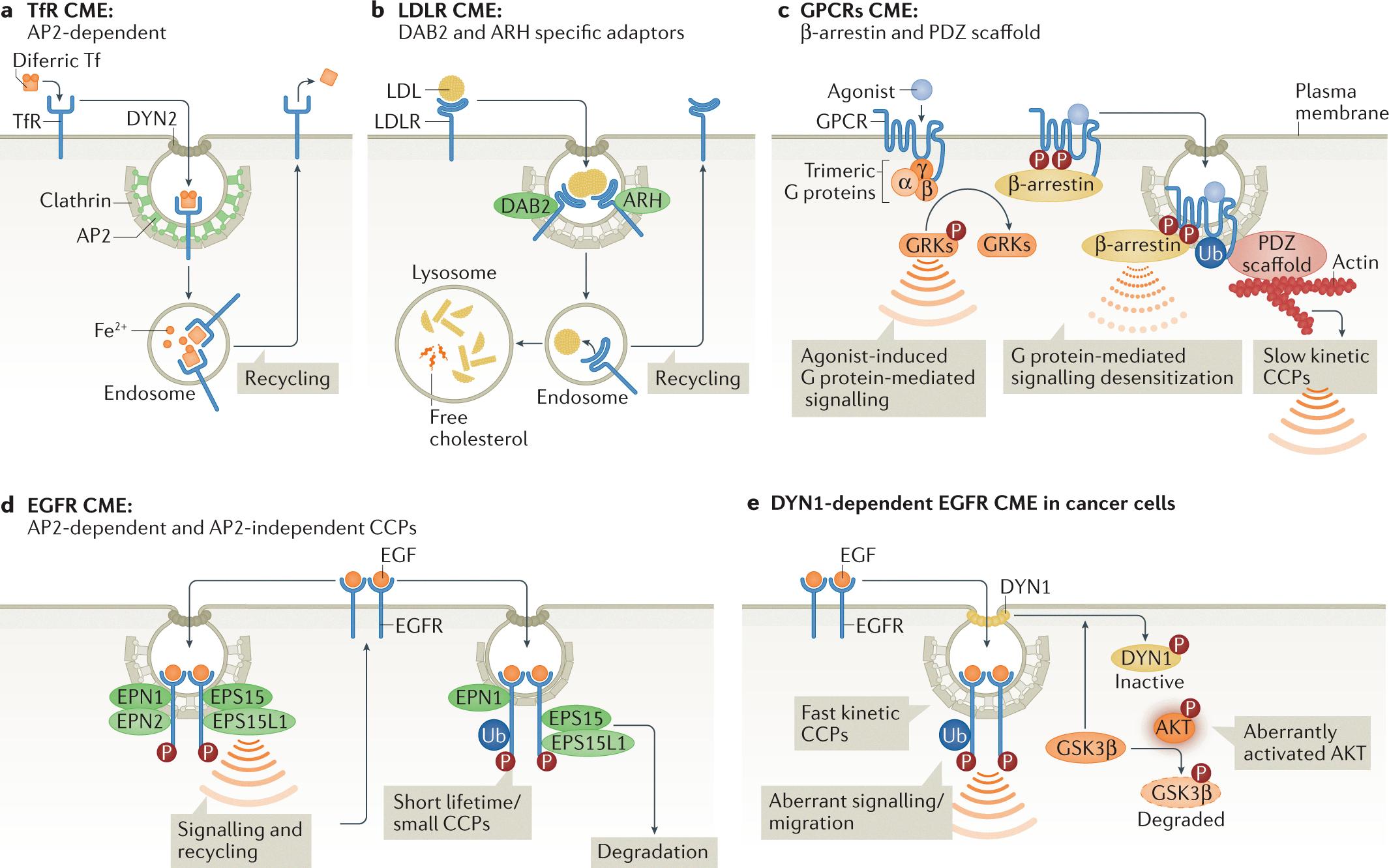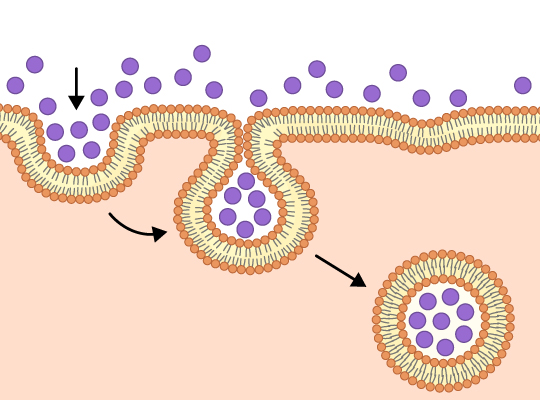Endocytosis is the process by which cells engulf and internalize materials from their surroundings. This process is essential for the uptake of nutrients, the removal of waste, and communication between cells. Endocytosis is an energy-dependent process that requires the use of adenosine triphosphate (ATP) to fuel the movement of substances in and out of the cell.
There are three types of endocytosis – phagocytosis, pinocytosis, and receptor-mediated endocytosis. Phagocytosis is the process by which cells engulf and digest large particles such as bacteria and dead cells. Pinocytosis is the process by which cells engulf small particles such as fluids and solutes. Receptor-mediated endocytosis is a specific form of endocytosis that involves the binding of ligands (specific molecules) to receptors on the surface of the cell membrane. Once bound, the receptor-ligand complex is internalized into the cell via a vesicle.
All three forms of endocytosis require energy in the form of ATP. This is because the movement of substances across the cell membrane requires a concentration gradient, which is maintained through the use of energy. In addition, the process of vesicle formation and movement withn the cell also requires energy.
In receptor-mediated endocytosis, ATP is required for the formation of the clathrin-coated pit, which is a specialized structure on the surface of the cell membrane that helps to internalize the receptor-ligand complex. The formation of the clathrin-coated pit requires the use of ATP to drive the movement of vesicle-forming proteins to the cell membrane.
Similarly, in phagocytosis, ATP is required for the movement of the actin cytoskeleton, which is necessary for the engulfment of large particles such as bacteria. The actin cytoskeleton is a network of proteins that provides structural support to the cell and helps to facilitate movement.
Endocytosis is an energy-dependent process that requires the use of ATP to fuel the movement of substances in and out of the cell. The three types of endocytosis – phagocytosis, pinocytosis, and receptor-mediated endocytosis – all require energy for the movement of vesicles and the maintenance of concentration gradients. Understanding the energy requirements of endocytosis is important for understanding cellular processes and developing new treatments for diseases that involve abnormalities in endocytosis.
The Energy Requirements of Endocytosis and Exocytosis
Both endocytosis and exocytosis require energy in the form of adenosine triphosphate or ATP. Endocytosis is the process by which substances are brought into the cell through the formation of a vesicle. There are three types of endocytosis – phagocytosis, pinocytosis, and receptor-mediated endocytosis. In all three types, energy is required to form the vesicle and move the substance into the cell. Exocytosis, on the other hand, is the process by which substances are released from the cell. This process also requires energy in the form of ATP to move the substance out of the cell through the fusion of a vesicle with the cell membrane. Therefore, both endocytosis and exocytosis are energy-dependent processes.

Does Exocytosis Require Energy?
Exocytosis is an energy-requiring process. It involves the fusion of secretory vesicles with the cell membrane, which requires energy to overcome the electrostatic repulsion between the negatively charged phospholipid bilayer of the vesicle and the cell membrane. Additionally, the expulsion of the vesicle contents into the extracellular space requires energy to overcome the solvation shell of water molecules surrounding the molecules being transported. Therefore, exocytosis is an active process that requires the input of energy in the form of ATP (adenosine triphosphate) to drive the fusion and expulsion of the vesicles.
The Need for Energy in Endocytosis
Endocytosis is a cellular process that involves the uptake of particles or macromolecules from the extracellular environment into the cell. This process requires energy because the cell needs to overcome the repulsive forces between the molecules in the extracellular environment and the membrane of the cell. The energy required for endocytosis is obtained from the hydrolysis of ATP, which fuels the molecular motors responsible for transporting the vesicles containing the endocytosed material into the cell.
Furthermore, endocytosis involves the formation of a membrane-bound vesicle that engulfs the extracellular material. This process requires the reorganization of the cell membrane and the formation of a new membrane, which also requires energy. The energy required for the formation of the new membrane is obtained from the hydrolysis of ATP, which provides the necessary building blocks for the synthesis of the membrane components.
Endocytosis requires energy because it involves the transport of large particles agaist the concentration gradient and the formation of a new membrane-bound vesicle. The energy required for these processes is obtained from the hydrolysis of ATP, which fuels the molecular motors and provides the building blocks for membrane synthesis.
Does Exocytosis Require ATP?
Exocytosis requires ATP. Exocytosis is the process by which intracellular vesicles fuse with the plasma membrane, releasing their contents to the extracellular environment. This process requires the energy provided by ATP to power the fusion of the vesicle membrane with the plasma membrane. Without ATP, the fusion process cannot occur, and the contents of the vesicle would not be released outside of the cell. Therefore, ATP is crucial for exocytosis to occur and for the cell to perform its functions.
Endocytosis vs Exocytosis
Endocytosis and exocytosis are two fundamental processes that occur in cells. Endocytosis is a process by which cells bring in materials or particles from the outside environment into the cell. This process involves the invagination of the cell membrane aroud the material or particle to form a vesicle, which is then brought into the cell. There are three types of endocytosis: phagocytosis, pinocytosis, and receptor-mediated endocytosis.
Phagocytosis is the process by which cells engulf large particles or microorganisms, such as bacteria or dead cells. Pinocytosis, on the other hand, is the process by which cells take in small molecules and fluids from the environment. Receptor-mediated endocytosis is a more specific process that involves the binding of specific molecules to receptors on the cell surface before being taken into the cell.
Exocytosis, on the other hand, is the process by which cells release materials or particles from the inside of the cell to the outside environment. This process involves the fusion of vesicles with the plasma membrane, which then releases the contents of the vesicle into the extracellular space.
Both endocytosis and exocytosis are essential processes for maintaining the proper function of cells. Endocytosis allows cells to take in nutrients and other essential molecules, while exocytosis allows cells to secrete hormones, enzymes, and other signaling molecules.

Source: nature.com
Does Pinocytosis Require Energy?
Pinocytosis requires energy in the form of adenosine triphosphate (ATP). ATP is a molecule that carries energy within cells and is necessary for vrious cellular processes, including pinocytosis. During pinocytosis, the cell membrane invaginates, or folds inward, and forms a small pocket that encloses extracellular fluid and any dissolved substances. The pocket then pinches off and becomes a small vesicle inside the cell. This process requires energy to occur and is essential for the cell to take up nutrients and other substances from the extracellular environment. Without ATP, the cell would not be able to carry out pinocytosis or other essential cellular processes.
The Role of ATP in Phagocytosis
Phagocytosis requires ATP. ATP is necessary for the energy-consuming processes that take place during phagocytosis, such as membrane extension, engulfment of the target, and formation of the phagosome. These processes involve the activation of multiple signaling pathways, which require the participation of ATP-dependent enzymes, such as kinases and phosphatases. Furthermore, ATP is also necessary for the maintenance of the cytoskeleton, which is essential for the movement and deformation of the cell membrane during phagocytosis. without ATP, phagocytosis cannot occur efficiently, resulting in impaired immune responses and increased susceptibility to infections.
Endocytosis: The Process
Endocytosis is a vital cellular process that allws cells to absorb external material by engulfing it with the cell membrane. The process of endocytosis involves the formation of a small pocket or vesicle in the cell membrane that surrounds the external material to be absorbed. The pocket then pinches off from the cell membrane and moves into the cytoplasm of the cell.
There are two main types of endocytosis: pinocytosis and phagocytosis. Pinocytosis, also known as “cell drinking,” involves the uptake of fluids and dissolved molecules. In this process, the cell membrane forms small vesicles around extracellular fluid, which then enters the cell. Phagocytosis, also known as “cell eating,” involves the uptake of solid particles such as bacteria, dead cells, or other large particles. In this process, the cell membrane surrounds the particle and engulfs it, forming a phagosome. The phagosome then fuses with lysosomes in the cell, where the particle is broken down and digested.
Endocytosis is an essential process for the survival and function of all cells. It enables the cell to take in nutrients, remove waste, and maintain homeostasis.
Endocytosis Requirements
Endocytosis is a process by which cells take in substances from their external environment through the formation of a vesicle made from the cell membrane. This process requires several components, including proteins and lipids that make up the plasma membrane. These components not only provde structural integrity to the cell membrane, but also aid in the flexibility of the membrane, allowing it to form the necessary shape for vesicle formation. Additionally, proteins found on the surface of the cell membrane are involved in the recognition and binding of specific molecules, which initiate the formation of the vesicle. Thus, both proteins and lipids are essential components for endocytosis to occur, facilitating the uptake of molecules into the cell.

Transportation That Does Not Require ATP Energy
Passive transport is a type of cellular transport that does not require any energy expenditure in the form of ATP. It occurs along the concentration gradient of the molecule being transported, from an area of higher concentration to an area of lower concentration. There are several types of passive transport, including simple diffusion, facilitated diffusion, and osmosis. In simple diffusion, small, non-polar molecules such as oxygen and carbon dioxide move across the cell membrane from an area of high concentration to an area of lower concentration. Facilitated diffusion involves the movement of larger or charged molecules across the membrane with the help of transport proteins, but still occurs without the use of energy. Osmosis, on the other hand, is the movement of water molecules across a selectively permeable membrane from an area of higher water concentration to an area of lower water concentration. passive transport is an essential process that allows cells to efficiently transport molecules without expending energy.
The Role of ATP in Biological Processes
ATP, or adenosine triphosphate, is a vital molecule that proides energy for various cellular processes. Many cellular processes require ATP, including muscle contraction, nerve impulse propagation, ion transport, substrate phosphorylation, and chemical synthesis. For instance, muscle contraction requires ATP to power the movement of muscle fibers. Nerve impulse propagation requires ATP to maintain the ion gradients across the cell membrane. Ion transport also requires ATP to maintain the concentration gradients across cell membranes. Substrate phosphorylation, a process by which phosphate groups are added to molecules, also requires ATP as a source of energy. chemical synthesis, such as the synthesis of RNA and DNA, also requires ATP as an energy source. ATP is required for many essential cellular processes that are necessary for life.
Facts About Endocytosis
Endocytosis is a process in which cells take up materials from outside the cell by forming membrane-bound vesicles called endosomes. Here are two facts about endocytosis:
1. There are three types of endocytosis: phagocytosis, pinocytosis, and receptor-mediated endocytosis. In phagocytosis, cells engulf large particles such as bacteria or dead cells. In pinocytosis, cells take up small solutes and fluids. Receptor-mediated endocytosis is a highly specific process that involves the binding of ligands to receptors on the cell surface, which triggers the formation of coated vesicles.
2. Endocytosis plays an important role in a variety of cellular functions, including nutrient uptake, cell signaling, and immune defense. For example, cells in the small intestine use endocytosis to absorb nutrients from the digestive tract. Cells of the immune system use endocytosis to engulf and destroy invading pathogens. Endocytosis also plays a critical role in the regulation of signaling pathways, as receptors on the cell surface are internalized and either recycled back to the surface or degraded in lysosomes.
Does Endocytosis Require a Protein?
Endocytosis requires proteins for its execution. Endocytosis is a cellular process by which cells internalize particles, such as nutrients, enzymes, and signaling molecules from their external environment. The process of endocytosis involves the formation of a vesicle from the plasma membrane that encloses the extracellular material and transports it into the cell. This process is mediated by a group of proteins that work together to facilitate the formation and movement of the endocytic vesicle.
One of the key proteins involved in endocytosis is clathrin, which assembles onto the membrane to form a coated pit that invaginates to form a vesicle. Other proteins, called adaptor proteins, are also involved in the process. These adaptors help to recruit clathrin to the membrane and to select cargo molecules for internalization.
In addition to clathrin and adaptor proteins, other proteins are also involved in endocytosis, including dynamin, which constricts the neck of the vesicle to facilitate its release from the membrane, and various membrane-associated proteins that regulate the process.
Thus, endocytosis is a complex process that requires the coordinated action of multiple proteins to facilitate the internalization of extracellular material into the cell. Without thse proteins, endocytosis would not occur, and cells would be unable to take up nutrients, remove waste, or respond to extracellular signals.
Does Exocytosis Require Protein?
Exocytosis requires proteins. The process of exocytosis involves the fusion of secretory vesicles with the plasma membrane, which is mediated by a complex network of proteins. These proteins include SNARE (soluble N-ethylmaleimide-sensitive factor attachment protein receptor) proteins, which are responsible for bringing the vesicle and plasma membranes into close proximity and initiating the fusion process. Other proteins involved in exocytosis include Rab proteins, which are involved in vesicle transport, and tethering factors that help to anchor vesicles to the plasma membrane. Additionally, calcium ions play an important role in exocytosis, as they trigger the fusion of the vesicle with the plasma membrane. the coordinated action of these proteins is essential for the efficient and accurate delivery of secretory products out of the cell.
Conclusion
Endocytosis is a cellular process that requires energy in the form of ATP to transport substances into the cell. The thre types of endocytosis – phagocytosis, pinocytosis, and receptor-mediated endocytosis – all require ATP to function. This energy is used to move large particles such as macromolecules into the cell. Exocytosis, the process of expelling secretory vesicles out of the cell, also requires ATP. Therefore, it is evident that endocytosis and exocytosis are energy-consuming processes that play a crucial role in maintaining the cellular environment. endocytosis does require energy, and ATP serves as the primary source of energy for this cellular process.
